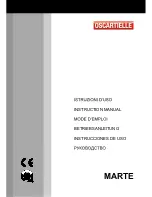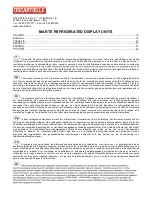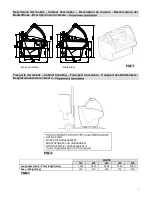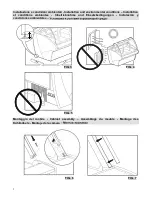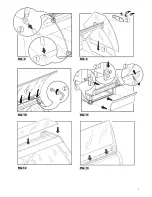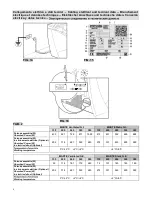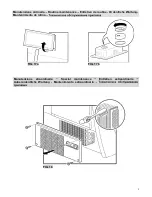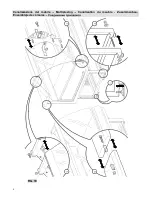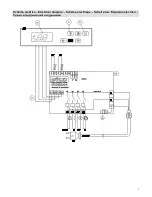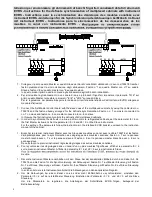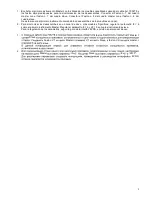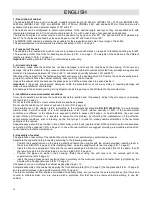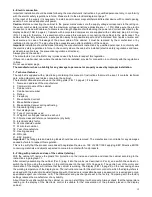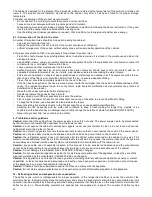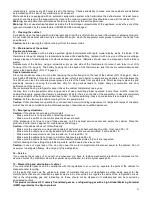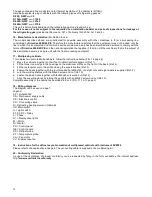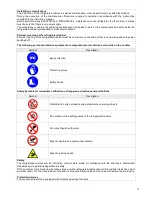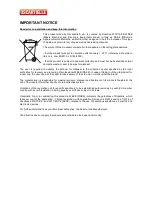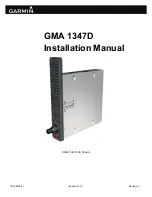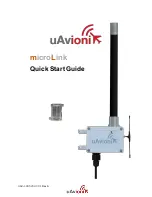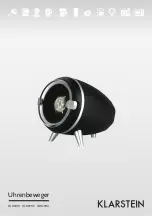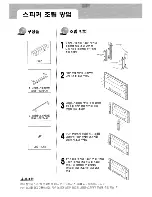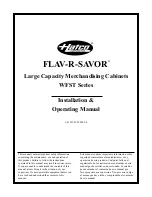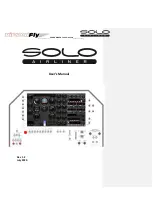
20
The cabinet is designed for the display of food products, which are stored at the temperature of the product, and does not
lower it. The product should therefore be placed in the cabinet only after it has been chilled to its proper storage
temperature.
For better conservation of the product we recommend:
-
Do not obstruct the cold recycle vents that ensure a correct air flow.
-
Leave some room between products to ensure good air circulation.
-
When placing more products inside a partially filled cabinet, in addition to following the above instructions, it is a good
rule to place the new products underneath the existing ones.
-
Use the sliding rear closures (available on request), that in addition to storing products better, save energy.
8.1 - Conservation of the fish in the store
A number of important rules should be followed in loading the cabinet:
-
use a layer of granular type ice;
-
arrange the products so as not to obstruct the correct circulation of chilled air;
-
uniform arrangement of the goods, without empty zones, will ensure better operation of the cabinet.
For proper conservation of fish it is necessary to follow these important rules:
-
Fresh fish should always be kept refrigerated, when it is delivered, when it is stored in the warehouse and when it is
displayed for sale.
-
Live shellfish (clams, oysters, mussels) should be kept separate from the other products and not allowed to come into
contact with ice or cold water that would kill them.
-
Leave oysters and other crustaceans free to breathe.
-
Seafood products, after the skin, shell or scales have been removed, should never come into contact with ice or
unwashed ornamental elements. Ice, as it melts, may release soluble aromas making the water impure.
-
Fillets should be placed on sheets of paper, plastic bags or metal trays and nested in ice.The layers should be thin so
that no part of the fillet is ever more than 40 mm from the ice, to ensure adequate chilling.
-
Trays, if used, should be completely nested in the ice up to the rim.
-
If the fish has been gutted or the head removed, place it with the tail higher than the head to facilitate drainage of the
cavity. The residual moisture inside the cavity favors rapid bacterial proliferation and accelerates the process of
deterioration of the product.
-
Rinse the fish under cold water before displaying it.
-
Constantly replace the goods as they are sold.
-
Display only as much fish as necessary to prepare the window.
-
Fish is a poor conductor of heat. Do not stack them one on top of the other to prevent insufficient chilling.
-
To keep the fish fresh, use abundant ice also between the layers.
-
Never stick the price markers directly in the fish because they can cause bacterial proliferation.
-
Spraying the fish frequently with ice water will contribute to keep it fresh-looking for longer.Tiny crystals of ice
scattered on the fish also have a detergent action that prolongs the duration of whole fish (NEVER ON FILLETS).
-
Never let a product drip, ooze or drain onto another.
9 - Prohibitions and regulations
Caution
: disconnect the cabinet from the power supply in case it is not used. The power supply has to be disconnected
by the remote-control switch fitted upstream from the power socket.
Caution:
do not expose the cabinet to atmospheric agents, never use jets of water to clean it, do not touch and use the
cabinet with wet or damp feet or hands.
Caution:
do not remove guards or covers that require tools to remove them, never remove the cover on the power panel.
Caution:
do not place heavy loads on the shelves and in the cabinet, and never climb on the counter top.
Caution:
the refrigerator system does not chemically alter the defrost water produced by the cabinet in any way. This
water is condensed steam from the air that circulates inside the cabinet. In any case, the water produced by the systems
should always be drained into the sewer system or treatment plant in accordance with the laws in force.
Caution:
any possible use not explicitly indicated in this manual is to be considered hazardous and the manufacturer
cannot be held responsible for any damage caused by improper, erroneous and unreasonable use of the cabinet.
Caution
: Do not damage the refrigerant circuit (IEC60335-2-89 and changes)
Caution
: Do not use electrical appliances inside the food storage compartments of the appliance, unless they are of the
type recommended by the manufacturer (IEC60335-2-89 and changes)
Caution
: This appliance is not intended for use by persons (including children) with reduced physical, sensory or mental
capabilities, or lack of experience and knowledge, unless they have been given supervision or instruction concerning use
of the appliance by a person responsible for their safety.
Caution
: Children should be supervised to ensure that they do not play with the appliance.
Caution
: Do not store explosive substances such as aerosol cans with a flammable propellant in this appliance.
10 - Defrosting cabinet and evaporation of condensation
The defrost cycle, which is indispensable for proper operation of the refrigerated cabinet, is under the control of the
electronic device, that temporarily stops the compressor and allows the evaporator to eliminate any accumulated ice (this
operation can be simplified by introducing armored heating elements that help the ice on the evaporator to melt when the
defrost cycle is on. These heating elements are optional and are supplied on request. The number of defrost cycles

